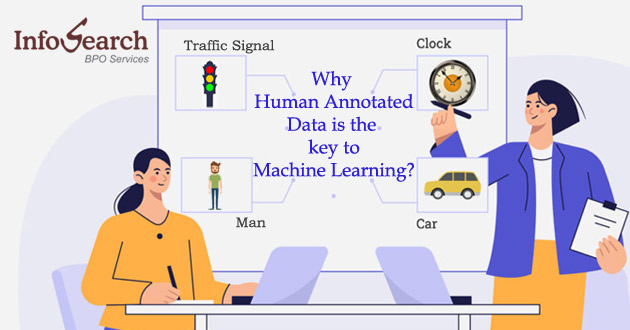Both human and machine intelligence are the need for machine learning models to work. A human-in-the-loop model is one in which human judgment is used to improve the performance of a machine learning model on a continuous basis. Data annotation, too, necessitates the use of humans. Machine learning relies on the human-annotated data heavily too. Subjectivity, intent, and clarification are all introduced by human judgment when it comes to data annotation. More than one human is also required to reach a consensus in some ambiguous cases, such as when determining whether a search result is relevant or not.

When training a computer vision or pattern recognition solution, humans are also needed to identify and annotate visual data or instruct a computer vision or pattern recognition solution for Machines. Like, be it for highlighting various items such as traffic signs, trees, and other objects to make it identifiable for computers. Most AI-based applications require models to be consistently trained in order for them to be adaptable to changing conditions in various scenarios. Here, we’ll look at why human-annotated data is the key topic to machine learning.
Let’s begin!
1) Scalable Solution Providers:
Machine learning is one such aspect that always requires exact annotated data and is also of greater accuracy. And when talking about reliability, it also serves as that model which can learn and anticipate real scenarios. So, here the humans are the ones who annotate data with care and double-check the annotations with appropriate tools and methodologies.
Humans may annotate data for various purposes following model development requirements while working with scalable solutions to extend their workstations or annotators and deliver a scalable solution to each customer.
When irregular forms come up for annotations, the task automatically has many errors, especially in terms of quality. People then can check better at a higher rate and help get a successful result. Humans are the ones who help annotate the visual data according to object dimension or form in such instances. Due to manual inspection and validation by people who also validate such data during training, the accuracy and dependability are at their highest levels.
Thus, proving their significance as the best cross-checkers.
2) Search Relevance for Various Markets Has Been Improved:
To increase the quality of its search results, online search engines require a large number of data sets, which must be presented in accordance with global culture and market trends. Many such human-annotated data sets assist the company reach its aim of developing a successful machine learning model for the best reaction and forecasts.
Human-annotated data sets are also tagged using the appropriate approach and video annotation tools to make them identifiable to computer visions or machines. Different types of such data set annotated by humans for various scenarios assist the model in learning with a broader range of data, allowing it to make more exact predictions based on the behavior and patterns learned during model training.
Wrapping Up!
Machine learning thus requires annotated data by humans. Humans are just better at coping with ambiguity, recognizing purpose, and regulating subjectivity than machines. Or, in order to get an agreement on whether a search engine result is relevant, several people’s involvement is highly required.
Data annotation features in specialist software or automated tools can be confined to specific sorts of photos or objects in forms. But humans, on the other hand, can annotate a wide range of shapes and sizes of things in a variety of formats. They can complete this task with complete customization for a cost-effective and versatile annotation service. So, pick one of the new firms that offer human-annotated datasets for machine learning and deep learning in a variety of industries and sub-fields.
Infosearch offers professional data annotation & labelling services for AI, Machine Learning, Image recognition, Autonomous vehicles & Robotic Industries. Contact us right now at : enquiries(at)infosearchbpo(dot)com








Recent Comments